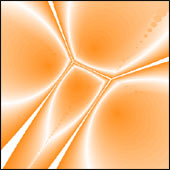Polynomiography

In this web site I introduce a technique which I have called "polynomiography." Polynomiography stands for visualization of polynomials. And polynomials are the most fundamental class of functions in all of mathematics, used in virtually every branch of science.
Polynomiography has many facets and could appeal to anyone as it requires no knowledge of mathematics. As an artistic tool it can be used by everyone: children, high school students, and the general public. Using a polynomiography software is no more complicated than using an ordinary camera: we choose a subject to photograph, adjust the settings, and then shoot a picture. Except that in polynomiography we shoot pictures of polynomial equations, and the camera is the polynomiography software. I call this picture a "polynomiograph." Employing our own creativity and imagination, we also have the ability to zoom in or color the initial polynomiographs we generate. There are infinitely many polynomials and infinitely many ways we can shoot pictures of them. The range and diversity of polynomiographs is indeed quite extraordinary.
For a dozen years I have been fascinated with the theory for solving polynomial equations, a problem which is a few thousand years old. Polynomiography is the fruit of this research and is made possible by our present computer technology. I believe polynomiography is not only a new art form but a great educational tool as well. One may view polynomiography merely as a toy for generating beautiful images while ignoring the potential value for educational use. Indeed, viewing it only as a means for generating nice images makes it a very nice toy. The true beauty of this kind of toy is that it has mass appeal: from the young, casual user to a serious (or not-so-serious) artist; from a lover of the arts to a scientist or theoretical physicist or pure mathematician who is only interested in its theoretical aspects.
Having given several presentations on polynomiography to general audiences, specialized groups, and university and high school students, I have witnessed a great deal of interest in the connections between mathematics and art, as revealed by polynomiography. I have also received enthusiastic email from viewers of earlier versions of this web site with comments that are extremely rewarding, both from an artistic and educational point of view. These comments support my conviction that polynomiography is indeed an exciting new art form . Our present technology has progressed so much so that we are now ready and capable of including into our old curriculum some new findings. It is now possible, and indeed instructive, to teach properties of polynomials through visualization. I have received beautiful questions such as, "What is a polynomial?," even from enthusiastic 7th graders. These are signs of new intellectual curiosities. We should be ready to accept visualization as both a new educational tool and a new art form.
Polynomiography is certainly not the only technology for creating computer generated art. It does for instance overlap with fractals in the sense that some previously given fractal images are polynomiographs according to the new definition. But polynomiographs are not necessarily fractal. The underlying objects are polynomials and polynomiography is intended to emphasize the purpose in the generation of the images and the means by which the images are obtained. I also feel that there lies more variety, diversity, control, creativity, and surpises to be had through polynomiography than typical fractal images. I remain convinced that polynomiography will bring new insights into the ancient problem of root-finding, even for the experts in the field.
A polynomial may be completely characterized by a finite collection of points in the Euclidean plane. These points are called its "roots" or "zeros." Each root "rules" a certain "territory." Thus the roots divide the Euclidean plane into regions of their own territories. The rule according to which the territories are determined is carried out according to what is called an, "iteration function." And there are infinitely many iteration functions.
In a sense polynomiography can be viewed as "painting by points," or "painting by numbers." In this sense it is one of the most minimalistic way to create artwork. But even as few as ten, twenty or thirty points can produce such a fantastically complex, yet diverse set of images unlike any a human being could produce in a lifetime.
It remains as one of my primary goals to bring polynomiography to the general public, as well as specialized groups, artists, scientists, college students, high school students, middle school students, and even children. I hope to do this through books, software, and my own artwork. Ultimately, I would like to introduce software that would be user friendly yet very sophisticated. Someday it may even be possible to establish an online polynomiography magazine where the users of polynomiography software can share their discoveries. The implementation of the above goals however requires support , funding, and time.
The interactive software released on this web site should be viewed as a software that will only give a flavor of polynomiography. It may not result in the kind of images displayed on this web site or within the included article(s).

 Interview with Bahman Kalantari
Interview with Bahman Kalantari